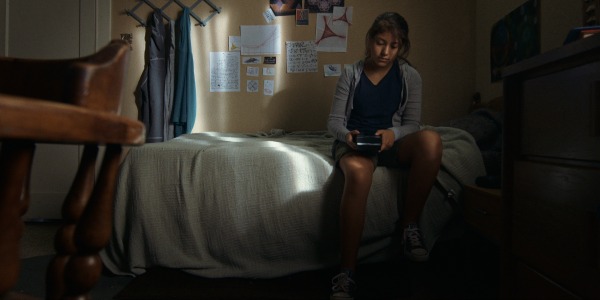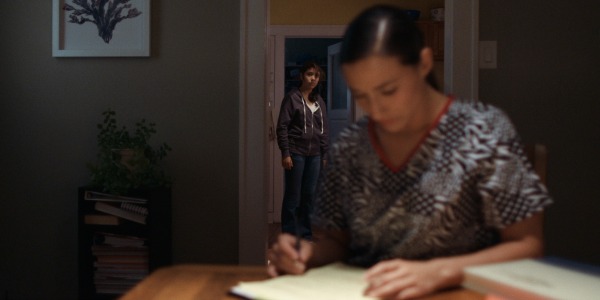CENTS: Praising The Smart Ones

Derek Sanchez is a writer with a B.A. in Film…
We have all seen the stereotypical math wunderkinds in film: the socially awkward, perpetually runny-nosed, pocket protector wearing guys who are ridiculed mercilessly.
Cents is not the first film to have a more enlightened take on this very antiquated image, but it also goes a step further. In addition to its solid cast, cinematic storytelling, and genuinely positive message, the film also features an almost completely female cast.
Smart Women, Young and Old
Julia Flores stars as Sammy Baca, the twelve year old math wiz who can figure out complex calculus equations in her head. Far from the typical geek, Sammy exists in a kind of self-imposed exile at her middle school, as she deals with a past embarrassment from people she thought were her friends. As her busy mom Angela (Monique Candelaria) does her best to get into medical school, Sammy finds a way to make money with her former friend’s penny drive.
Spunky and smart, Flores is the charming center of the film. With a sarcastic remark for nearly every situation, she manages to balance that fun trait with a realistic vulnerability. Yes, Sammy pushes others away, but she also yearns to simply fit in like any other twelve year old. That is what makes the character so genuine.
Her plan is actually incredibly intricate and intelligent despite its dishonesty. She executes it perfectly, finding ways to manipulate her partners in surprisingly confident ways. She almost comes off as an antihero and it serves her antisocial side well.

Sammy’s young partners’ acting varies, with Jy Prishkulnik looking like she is having the most fun as the “popular girl” Hannah. While Emily (Claire Mackenzie Carter) has great comic timing, Lilie Kolic as Sammy’s former friend Katie is not developed very well. She is okay in the role, but the character feels a little empty. This is tragic since her character plays such an important role in the film.
Candelaria is also solid as the beleaguered Angela, especially in any scene with Flores. The two play off each other well, and have the chemistry of a real mother and daughter. There are scenes where Candelaria’s acting feels a little artificial, specifically when she confronts an admissions official at a med school, but it is never distracting.
Esodie Geiger has a small but pivotal role as Sammy’s unwanted mentor, Ms. Dyer. It is a nice change to have the mentor character, commonly portrayed by a white actor, played by a woman of color. Look at Dangerous Minds or Freedom Writers for examples of this unfortunate tendency in Hollywood films.
Cents should be praised for bucking common film traditions and featuring an almost completely female cast. There are male characters in the film, but none have speaking roles save the admissions official mentioned above. None of the women are “catty” to each other or bond in stereotypical romantic comedy ways like musical montages, either, and there is no shoehorned romantic subplot. These are simply women struggling through life like everyone else.

However, Angela’s medical subplot feels unrealistic. It is good to see her persevere not only for her daughter but also for any woman watching the film, but it felt out of place. The resolution of this subplot is also the only time the film truly resorts to a “happy ending” cliché, which is too bad considering how well the rest of the story is handled.
Show Me, Don’t Tell Me…But Maybe Tell Me A Little
Director Christopher Boone uses a number of visual cues to tell the film’s story. He zooms in on Sammy’s face during important scenes, taking full advantage of her expressive face. But he also uses these techniques to tell us her motivations behind her pyramid scheme.
We see Sammy silently gathering her pennies, hiding them in her room. The camera never shows us a reason behind her scheme, and Sammy never tells us. It is a mystery that endures for a while, until Boone’s camera shows us later in the film. I will not ruin it, but it is a motivation that makes sense for a twelve year old.
When we first meet Katie, Hannah, and Emily, we do not learn a whole lot about them. Because they are supporting characters, that is expected, but Boone uses those visual techniques to tell us a lot about them. We see Hannah picking and choosing who has the honor of donating pennies, establishing her as an elitist control freak. In one of the more hilarious scenes of the film, we see that Emily has an absolutely flawless room in a mess of a house. These are nice little character tics that tell us a lot about these characters.
Cents also gets creative, showing social media in a visual way. Instant messages are superimposed on screen rather than have characters vocally reacting to their phones or tablets. It is not the first time this cue has been used, but it is a nice touch that continues the visual storytelling well.

But the crowning visual storytelling achievement in the film is also the source of one of its more frustrating plot points. The film uses visual clues and flashbacks to show Sammy’s surprisingly intricate scheme to get even with Katie midway through the film. The scenes are executed well, coming off like the heist scene at the end of 2001’s Ocean’s Eleven, as they mess with audience interpretations of certain scenes.
On the other hand, Sammy’s reasons for this scheme are unclear. When Sammy approaches Katie about her pyramid scheme, it seems like a random encounter. For some reason, their previous friendship is not established until well after their alliance is made. The film seems so preoccupied with simply hinting at this friendship that it actually loses Sammy’s motivation for hating her. While the “show me, don’t tell me” approach is appreciated, this important plot point could use a little more telling.
Unapologetic Positivity
As the film comes to its conclusion, the pyramid scheme plot line is wrapped up pretty early in the third act. Cents loses a bit of its momentum at this point, before finding its footing again for a strong and positive ending. Part of it was a little disappointing because of the film Dope, and its thought-provoking conclusion was fresh in my mind. While the two films are completely different on the surface, they both deal with oppressed people (young African-Americans in Dope and young women in Cents) trying to make their way in the world.
While some prefer the cynically optimistic (or is it optimistically cynical?) ending of Dope, this film should not be discounted. While its conclusion is a little sappy, the overwhelmingly positive message that women should embrace their intelligence and push through any obstacles is an important one in today’s world. Cynicism has its place in film, but Cents proves that contemporary messages can lift us up in more positive ways.
Is positivity a strength or weakness in film today? Does it automatically turn you off if a film is overwhelmingly positive or negative?
Cents is available now on VOD and Digital HD.
Does content like this matter to you?
Become a Member and support film journalism. Unlock access to all of Film Inquiry`s great articles. Join a community of like-minded readers who are passionate about cinema - get access to our private members Network, give back to independent filmmakers, and more.
Derek Sanchez is a writer with a B.A. in Film Studies from San Francisco State University. While he enjoys writing his own films, he enjoys analyzing them to the smallest detail just as much. He runs his own film blog with an incredibly awesome name, Supermassive Film Stuff. However, his Twitter name is incredibly unoriginal.












